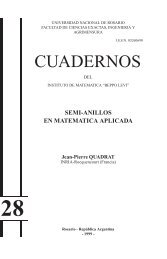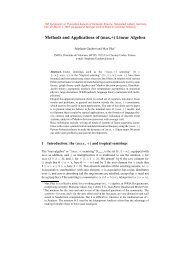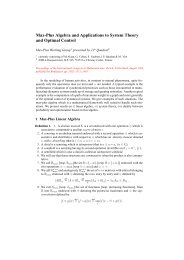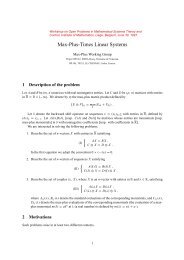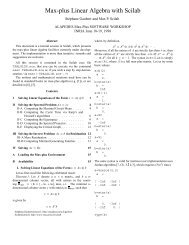View - Jean-Pierre QUADRAT - Free
View - Jean-Pierre QUADRAT - Free
View - Jean-Pierre QUADRAT - Free
You also want an ePaper? Increase the reach of your titles
YUMPU automatically turns print PDFs into web optimized ePapers that Google loves.
Notice that ∧ does not necessarily distribute over ⊕ or conversely. We canhowever state that∀a, b, c ∈D, (a ∧ b) ⊕ c ≤ (a ⊕ c) ∧ (b ⊕ c) (6)(a ⊕ b) ∧ c ≥ (a ∧ c) ⊕ (b ∧ c) (7)A lattice is distributive when equality holds true in (6)–(7). Indeed, equality ineither (6) or (7) implies the other equality too [8, p. 188]. The following twotheorems can also be found in [8, pp. 207 and 212 respectively].Theorem 3 A necessary and sufficient condition for a lattice to be distributiveis that}a ∧ c = b ∧ c=⇒ a = ba ⊕ c = b ⊕ cTheorem 4 Every multiplicative group G supplied with an order relation suchthat multiplication is isotone and G is a sup-semilattice is a reticulated groupand a distributive lattice.“Reticulated group” means in particular that multiplication distributes overboth the upper and the lower bounds (in our case, over ⊕ and ∧). Hence, inthis situation, all desirable properties hold true simultaneously. However, theassumption that a dioid is a multiplicative group is rather strong and it will nothold true for the dioid M considered in the second part.Definition 5 (Distributive dioid) A dioid D is distributive iff it is completeand∀C ⊂ D, ∀a ∈D, ( ∧ c) ⊕ a = ∧ ⊕ a) (8)c∈Cc∈C(c( ⊕ c) ∧ a = ⊕ (c ∧ a) (9)c∈Cc∈CNotice that here distributivity is required to extend to infinite subsets too.Moreover, both properties should be required now since one does not imply theother [8, p. 189].2.3 Matrix dioidsStarting from a “scalar” dioid D, consider square n × n matrices with entriesin D. Sum and product of matrices are defined conventionally after the sumand product of scalars in D. The set of n × n matrices supplied with these twooperations is also a dioid which is denoted by D n×n . The only point that deservessome attention is the existence of an identity element. Thanks to Axiom 5, theusual identity matrix with entries equal to e on the diagonal and to ε elsewhereis the identity element of D n×n . This identity matrix will also be denoted by e8



